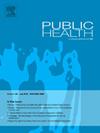结直肠癌的风险和参与粪便免疫化学测试筛查
IF 3.2
3区 医学
Q1 PUBLIC, ENVIRONMENTAL & OCCUPATIONAL HEALTH
引用次数: 0
摘要
目的基于粪便免疫化学试验(FIT)的结直肠癌(CRC)筛查的参与率在不同的社会人口亚组中存在差异。最大的健康收益可以在低参与率和CRC高风险的亚组中实现。我们调查了参与荷兰CRC筛查计划的不同社会人口亚组的CRC风险。研究设计基于人群的队列研究。方法纳入2018年和2019年荷兰CRC筛查项目邀请的所有个体。先前研究的数据,包括筛查数据和人口统计学特征,在2018年和2019年得到了CRC诊断的补充。采用多变量logistic回归来评估社会人口因素与结直肠癌风险之间的关系。结果总体参与率为72.3%,年龄调整后的CRC发病率为30.3 / 10000人。男性的参与率较低(69.7%),但CRC风险高于平均水平(35.1%)。在非参与者中,男性和女性之间结直肠癌风险的差异(OR: 1.28, 95% CI: 1.20-1.36)比参与者(OR: 1.41, 95% CI: 1.35-1.47)更不明显。低收入群体也有较低的参与度(降至60.0%)和较高的CRC风险(降至30.7%),但低收入群体和高收入群体之间的CRC风险差异仅在参与者中显着(OR最低五分位数vs最高五分位数:1.22,95% CI: 1.14-1.32)。相反,具有土耳其/摩洛哥移民背景的个体参与率较低(48.7%),但他们的CRC风险也较低(18.8;OR: 0.54, 95% CI: 0.46-0.63)。结论在荷兰CRC筛查项目中,低参与率组的CRC风险差异显著。干预措施应优先考虑最弱势群体的参与和CRC的风险。本文章由计算机程序翻译,如有差异,请以英文原文为准。
Risk of colorectal cancer and participation in fecal immunochemical test-based screening
Objectives
Participation rates in fecal immunochemical test (FIT)-based colorectal cancer (CRC) screening differ across socio-demographic subgroups. The largest health gains could be achieved in subgroups with low participation rates and high risk of CRC. We investigated the CRC risk within different socio-demographic subgroups with low participation in the Dutch CRC screening program.
Study design
Population-based cohort study.
Methods
All individuals invited for the Dutch CRC screening program in 2018 and 2019 were included. Data from a previous study, including screening data and demographic characteristics, were augmented with CRC diagnoses in 2018 and 2019. A multivariable logistic regression was used to assess the association between socio-demographic factors and risk of CRC.
Results
Overall participation was 72.3% and age-adjusted CRC incidence was 30.3 per 10,000 individuals. Males showed lower participation (69.7 %) but had a higher-than-average CRC risk (35.1). The difference in CRC risk between males and females was less pronounced among non-participants (OR: 1.28, 95% CI: 1.20–1.36) than participants (OR: 1.41, 95% CI: 1.35–1.47). Lower income groups also had lower participation (down to 60.0 %) and higher risk of CRC (down to 30.7), but the difference in CRC risk between low-income groups and high-income groups was only significant among participants (OR lowest vs highest quintile: 1.22, 95% CI: 1.14–1.32). Conversely, individuals with a Turkish/Moroccan migration background had lower participation (48.7 %), but their CRC risk was also lower (18.8; OR: 0.54, 95% CI: 0.46–0.63).
Conclusions
CRC risk varies significantly between low-participation groups in the Dutch CRC screening program. Interventions should prioritize the most vulnerable groups, considering both participation and risk of CRC.
求助全文
通过发布文献求助,成功后即可免费获取论文全文。
去求助
来源期刊

Public Health
医学-公共卫生、环境卫生与职业卫生
CiteScore
7.60
自引率
0.00%
发文量
280
审稿时长
37 days
期刊介绍:
Public Health is an international, multidisciplinary peer-reviewed journal. It publishes original papers, reviews and short reports on all aspects of the science, philosophy, and practice of public health.
 求助内容:
求助内容: 应助结果提醒方式:
应助结果提醒方式:


